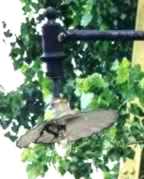ROLL CALL OF LUMINAIRES
I’ll admit it. There’s a big hole in my information on NYC lamppost manufacturers and makes, since I’ve not a clue of these designs’ actual names, nor their manufacturers. These are the luminaires that were still lurking about NYC when I first began taking note of lampposts back when I was a 4-eyed fat kid being duly bullied in grade school in the Swinging Sixties.
At any rate, lamppost maven Jeff Saltzman (link below at Bell) has graciously bestowed monikers on these designs, at least till I can discover what they’re actually called…


Retro Bells have recently reappeared on Manhattan streets.



MOON (late 40s-present)


WAVE (1910s-1960s)
Sightings of these are quite rare in NYC now.

(None are extant on public streets now, though collectors have some of them)
“Forgive them, they know not what they do.”
Many urban chroniclers speak of the shame of the 1964 destruction of Penn Station, as the 1910 Beaux Arts masterpiece fell to the wrecker’s ball.
At the risk of scourging a deceased equine, at Forgotten NY we’d point to a rather more mundane massacre that was occurring at about the same time–the wholesale sacrifice of the ornate castiron lampposts that first appeared about 1892 and had ruled the streets since the 1910s–as even more symptomatic of the increasingly jejune infrastructural developments of the time.
To put it in less syllables, it wasn’t a very good thing they were doing back then.
In 1960, a work crew has just dismembered a Type 24M “Corvington” castiron on DeKalb Avenue in Fort Greene. Note the discarded ‘Bell’ and ‘Cup’ luminaires at top right.
These posts had been around since 1950, and had only gradually begun making inroads on the older castiron legions. Around 1960, though, the change started happening in earnest. The rise of the Donald Deskey modular postsa couple of years later sealed all but a few of the castirons’ fate.
But our interest here lies with the strange, oblong thing on the corner. Why, just a short time before, an ornate “Corvington” longarmed pole had guarded the space. What’s there now?
Eastern Parkway has, in recent years, installed a series of retro-castirons that are an extrapolation of sorts on the park lamp design first created by designer Henry Bacon (who also designed the Lincoln Memorial in Washington) in 1907.
All B&W photos by Ron Ziel, from the collection of Lee Rosenzweig and Brian Merlis.
